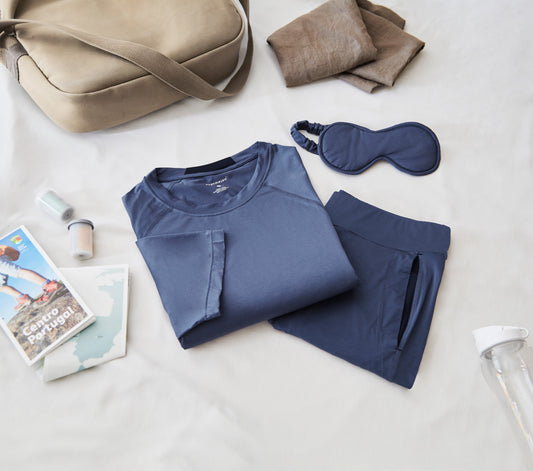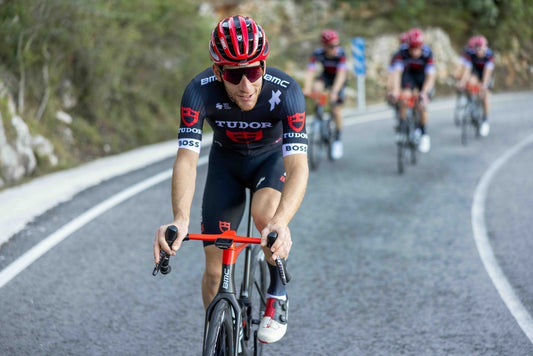
Running, Marathons & Recovery
Your fastest way back isn’t another “hack”—it’s high-quality sleep, smart nutrition, and a short block of easy movement. Dagsmejan’s Recovery sleepwear is designed to support nightly recovery with breathable, temperature-regulating fabrics and embedded minerals that reflect far-infrared (FIR) energy—an easy win while you’re off your feet.
Why recovery matters more than “one more workout”
Racing a marathon is controlled stress. Recovery is where your body rebuilds: restoring glycogen, repairing micro-damage, and recalibrating your nervous system. If you shortcut that process, you don’t just feel flat—you actually slow future progress.
“Dagsmejan helps me to sleep comfortably and optimize my nightly recovery.”
— Julie Derron, triathlete
The 10 top tips for marathon recovery
1) Make sleep your #1 session
-
Aim for 8–9 hours for 3–7 nights post-race.
-
Keep a cool, breathable micro-climate so your body doesn’t fight heat at night.
-
Consistent bedtime and wake time beat “catch-up” sleep.
How Dagsmejan helps: Recovery sleepwear is engineered for breathability and thermoregulation and includes FIR-responsive minerals designed to reflect body heat as far-infrared energy—supporting comfort while you sleep. Individual responses vary, but optimizing your sleep environment is a proven cornerstone of recovery.
“Every area is optimised in training, but sleep is the real base for my performance. Dagsmejan sleepwear has become an integral part of my sleep system since the first time I used it.”
— Ronnie Schildknecht, 11× Ironman champion

2) Refuel early, then eat normally
-
Within 60–90 minutes: carbs + protein (e.g., 1.0–1.2 g/kg carbs + 20–30 g protein).
-
Rebalance micronutrients over the next 72 hours with colorful, whole-food meals.
3) Rehydrate with a plan
-
Replace ~150% of body mass lost during the race across the first day (e.g., if you’re down 1 kg, aim for ~1.5 L net over baseline), including electrolytes.
4) Move—gently
-
Day 1–2: Short walks, light mobility.
-
Day 3–4: 20–30 min easy spin or jog if soreness allows.
-
No racing or hard workouts for at least 10–14 days.
5) Treat soreness strategically
-
Cold (short bouts) can curb acute soreness; heat helps stiffness later in the week.
-
Foam rolling and gentle stretching feel good—keep it light.
6) Guard your immune system
-
A marathon temporarily suppresses immunity. Prioritise sleep, hand hygiene, and balanced meals; avoid big crowds for a couple of days if you’re run-down.
7) Watch the signals, not the watch
-
Use RPE (how it feels), resting HR, and mood. If you wake unrefreshed, push training back.
8) Protect your feet and soft tissues
-
Treat blisters, keep nails trimmed, and rotate into supportive everyday footwear.
9) Plan your comeback
-
After 10–14 days, ease into short, easy runs. Re-introduce workouts by week 3–4. A fresh 5K/10K no sooner than week 4–6.
10) Build a sleep system you’ll actually use
-
Dark, cool room (16–19°C), quiet or white noise, and breathable sleepwear so your body can manage temperature without constant wake-ups.
“To choose a specific, technical clothing for sleep that helps the body to maintain an optimal sleeping climate is of very importance to me. I was already enthusiastic about the distinct sleep feeling after the first night and can recommend Dagsmejan to everyone, whether professional athlete or office employee.”
— Fabian Meeusen — Swiss Triathlon Champion
A simple marathon-recovery timeline
Race Day (Day 0):
-
Refuel (carbs + protein), rehydrate with electrolytes, early night in breathable, cooling sleepwear.
Days 1–2:
-
Walks + mobility only; short cold exposure if you like; prioritize 8–9 h sleep.
Days 3–7:
-
Optional 20–30 min easy spin/jog; light mobility/rolling; normal meals; consistent sleep.
Weeks 2–3:
-
Gradually increase easy volume; strides/short pickups if you feel fresh; still no racing.
Weeks 4–6:
-
Structured training returns. Consider a 5–10K rust-buster only if energy and sleep are back to baseline.
Why athletes choose Dagsmejan for the night shift
-
Breathable & temperature-regulating: Helps you stay comfortably warm (not sweaty) so you wake fewer times.
-
FIR-responsive mineral tech: Fabrics include embedded minerals designed to reflect far-infrared energy back to the body.
-
Soft, low-friction design: Tagless, flat seams, and 4-way stretch reduce irritation on tired skin and muscles.
-
Made in Europe: Responsible production with quality you can feel.
Try this: Pair Dagsmejan Recovery top + pants after long runs and race day for your best-quality sleep window of the entire block.
FAQs (quick answers runners actually search for)
How long does marathon recovery take?
Most runners feel normal by 2–3 weeks if sleep, nutrition, and easy movement are on point. Full neuromuscular pop can take 3–6 weeks.
When should I run again after a marathon?
If soreness is minimal, an easy 20–30 min run around Day 3–4 is fine. If you’re still heavy-legged, wait.
Are ice baths necessary?
Not necessary. Short cold exposure can reduce soreness early; use heat later for stiffness. Always start gently.
Where does sleepwear fit into recovery?
It’s part of your sleep environment—like a mattress and room temp. Breathable, thermoregulating, soft Recovery sleepwear removes friction (literally and figuratively) so sleep can do its job.







